Shankarpali are delicious flaky, melt-in-the-mouth flour fried cookies made for festive occasions like Diwali. Make them sweet or salted depending on your preference. Here I share both the sweet and savory versions of Shankarpali Recipe. You can also serve these crispy fried flour cookies as a tea-time snack.

Table of Contents
About Sweet Shankarpali
Shankarpali is also known as Diamond Cuts in South India. However the proportion of ingredients for diamond cuts is different. This results in a crispy and puffy texture in the diamond cuts unlike shankarpali that has a cookie like texture.
Shakkar Pare is very similar to shankarpali and is made in North India. There are some differences in the preparation of these snacks.
The sweet variation of shankarpali recipe is made with either sugar or jaggery. It is crispy and includes all-purpose flour, rava (semolina) and ghee.
For this shankarpali recipe, I have used sugar. My recipe gives you a crispy and crunchy sweet shankarpali that you will like.
Shankarpali can be fried or baked. Fried shankarpali is darker in color while baked shankarpali is usually lighter. Both taste amazing but have a slightly different texture.
The image below shows baked shankarpali.

Fried shankarpali tends to puffs up more than baked ones and they also have a more crumbly texture.
In contrast, baked shankarpali are softer and have a similar taste to baked cookies. You can use the frying method or the healthy baking method.
Shankarpali is typically served with other Diwali Snacks for the Diwali festival.
About Khare Shankarpali
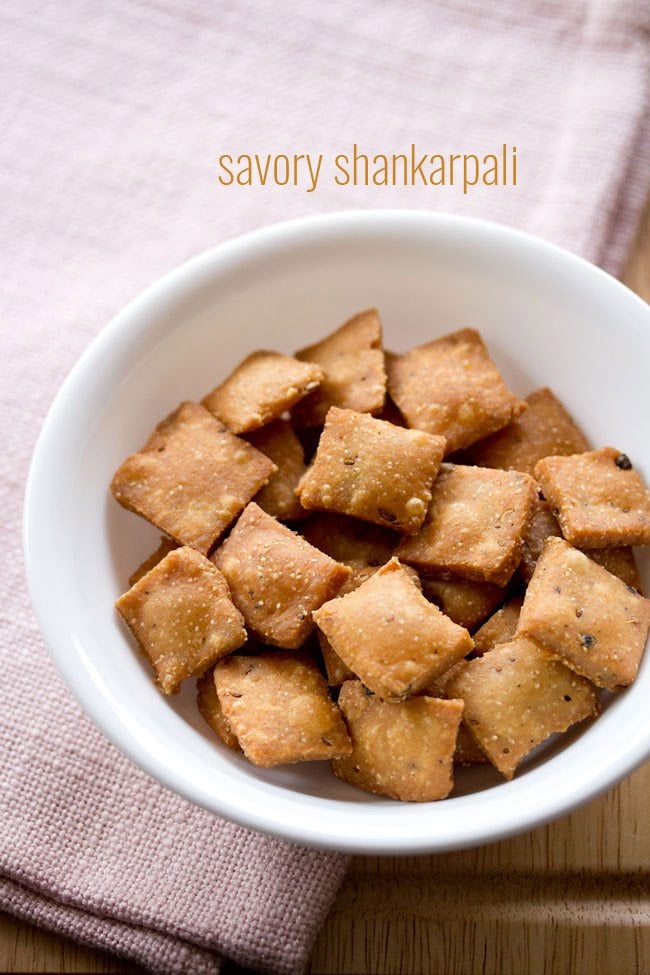
Salted Shankarpali (also known as Khare Shankarpali) are crispy and made with spices such as carom seeds, cumin, crushed black pepper, salt and do not include sugar.
For this savory and salty shankarpali recipe, I included whole wheat flour, all-purpose flour and semolina to make the dough.
If you want to intensify the flavors of the carom seeds then add more and omit the cumin. If you’d like to make jeera shankarpali then swap the carom seeds with cumin.
The great thing about this recipe is that you can alter the spices to suit your desired taste. You can make them spicy if you like by adding red chilli powder.
Once the salted shankarpali are done, allow them to cool down and serve them as an evening snack. They will keep for a couple of weeks in an airtight box or jar.
Both of these recipes are my Mom’s and she always makes them during festive occasions.
How to Make Shankarpali (Sweet)
Make Sweet Dough
1. First powder ½ cup of sugar in a mixer-grinder or spice grinder. Make a fine powder of the sugar granules.

2. Sieve 1.5 cups of all-purpose flour (maida), a pinch of salt and powdered sugar in a bowl. Then mix in ⅓ cup of fine rava (sooji or semolina). Add 2 tablespoons of warm melted ghee or warm oil.
Tip: Use 2 tablespoons of melted ghee or oil to make fried shankarpali and 3 tablespoons of melted ghee or oil to make baked shankarpali.

3. Firstly mix the warm oil or ghee with a spoon with the rest of the flour mixture. Then using your fingertips rub or mix the ghee or oil and the flour mixture together to get a breadcrumb-like consistency.
After this, the whole mixture should stick together and gather to form a ball when you press it in your palms (see image below).
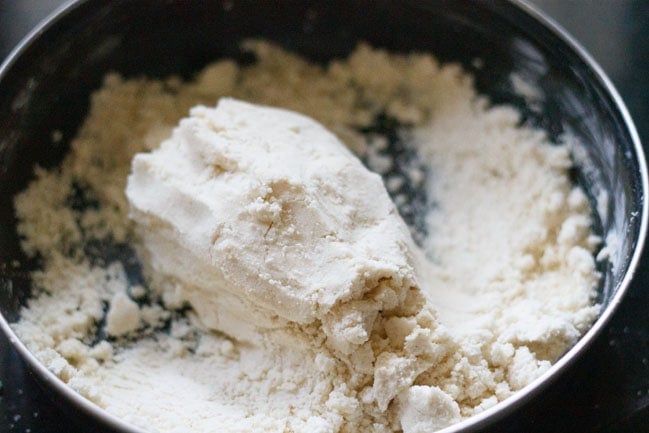
4. Drizzle or sprinkle 3 to 4 tablespoons of warm milk gradually while kneading. Add the milk 1 tablespoon at a time and gently mix.
The amount of milk you need to add will depend on the quality of all-purpose flour and rava. So add as required to make a stiff and firm dough.

5. Knead the mixture until you get a firm and stiff dough. Set aside and cover for 20 to 30 minutes at room temperature for the dough to rest.
Keep in mind that the dough must not be soft or sticky. Also do not knead the dough for too long as this can result in a chewy, doughy denser texture.

Assemble and Cut Shankarpali
6. Divide the dough into two or three parts. Make a neat ball of each part by rolling with your palms. Then with a rolling pin roll each dough ball into a circle having 5 to 7 mm thickness as shown in the below photo.
Keep these dough balls covered with a kitchen napkin as you work on rolling and cutting the dough.

7. Use a knife or pizza cutter and make diamond shapes in the dough. Discard the edges and join them together using other pieces of dough.
Keep any pieces of these shankarpali dough covered with a kitchen towel so that they don’t dry out.
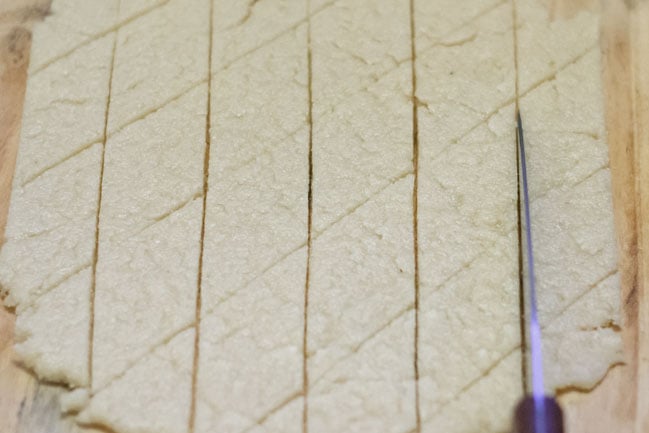
Fry Shankarpali
8. Heat oil for deep frying in a frying pan or kadai (wok). Let the oil become medium hot.
To check the temperature of oil, add one piece of shankarpali. If it comes up gradually the oil is ready. It should not come up too quickly or stay at the bottom of the oil.
Carefully and gently add the diamond-shaped shankarpali to medium hot oil. Do not add too much in one go. Fry in batches.
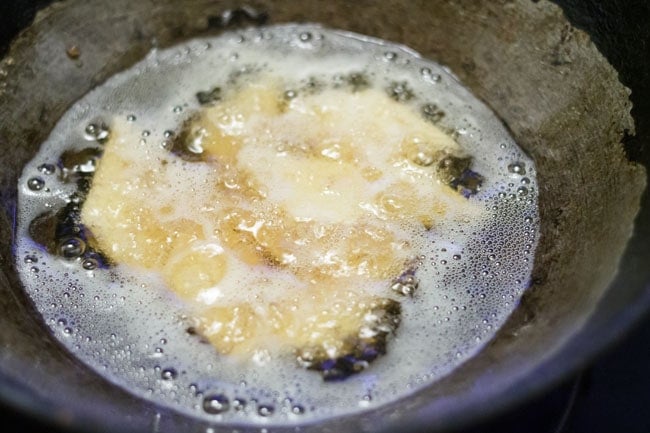
9. When you see that one side is golden, then using a slotted spoon turn over the shankarpali and continue to fry the second side until golden.
This way turn again a few times if needed and fry the shankarpali until evenly golden.

10. Use a slotted spoon to remove the fried shankarpali and drain on paper towels to remove excess oil.

Bake Shankarpali
11. For baking, preheat the oven at 180 Celsius (356 degrees Fahrenheit). Place the shankarpali in a baking tray and make sure there is some space between each shankarpali.
Bake for 20 to 25 minutes or until they look crispy and golden. Half way through baking turn them with a spatula if needed.
Below is an image of the baked shankarpali. Once they are baked remove them from the oven and leave them to cool on a wire rack.

12. Once cooled, store the shankarpali – whether you have fried or baked them, in an air-tight container or jar.

How to make Khare Shankarpali
Form Dough
1. Take ½ cup of whole wheat flour, ½ cup of all purpose flour and ¼ cup of fine rava (sooji) in a mixing bowl or plate.

2. Add the following spices and seasonings:
- ½ teaspoon of carom seeds (ajwain)
- ½ teaspoon of cumin seeds (jeera)
- ½ to ⅔ teaspoon of crushed black pepper
- ½ teaspoon of salt or according to taste

3. Mix very well with a spoon.
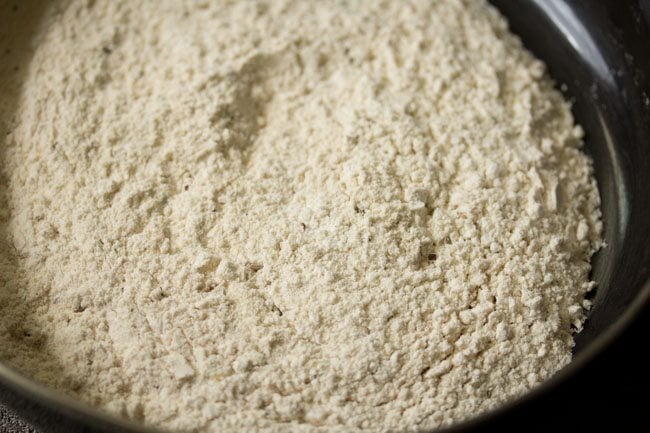
4. In a small pan, heat 2 tablespoons of ghee or oil until warm.
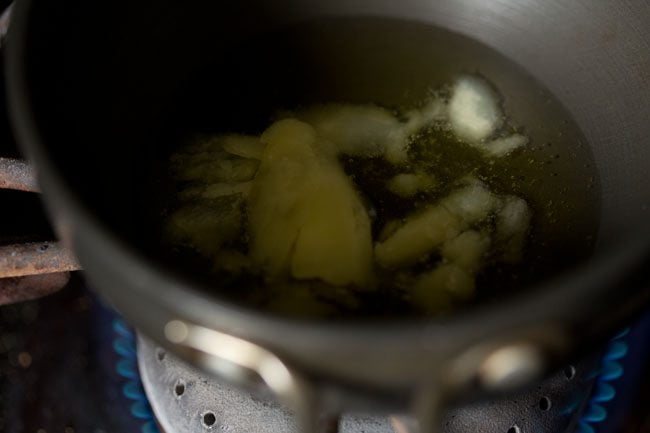
5. Add the warm melted ghee or warm oil to the flour mixture.

6. First mix with a spoon. Then use your fingertips to rub or mix the ghee or oil in the flour to create a breadcrumb-like consistency mixture.
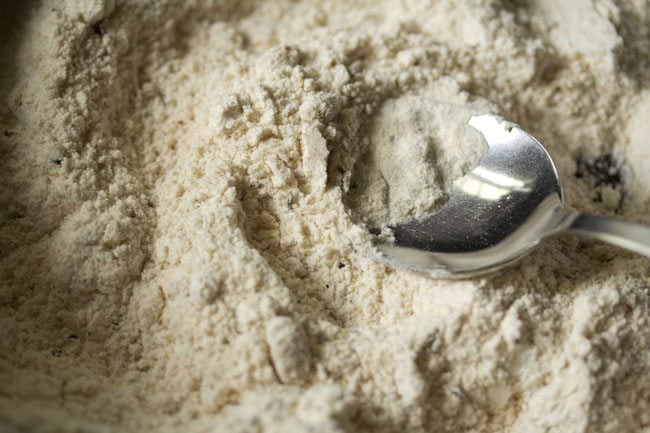
7. Take a portion of a mixture and press it in your palm. It should gather and hold itself like the image below.
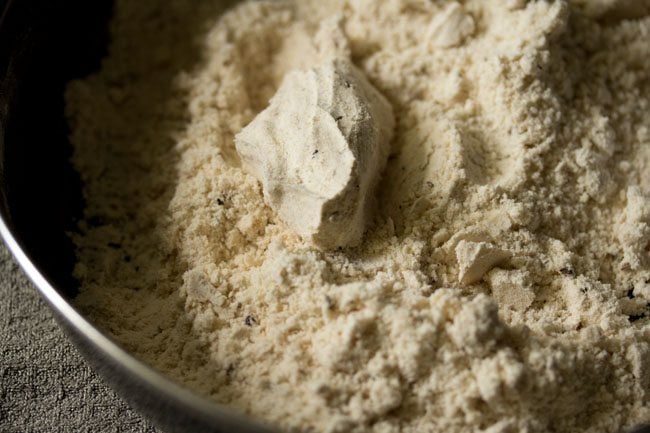
8. Add ½ cup of milk in portions to the dough and mix first. Then begin to knead. The milk should be at room temperature.
You can also use water instead of milk. Add as necessary in parts.
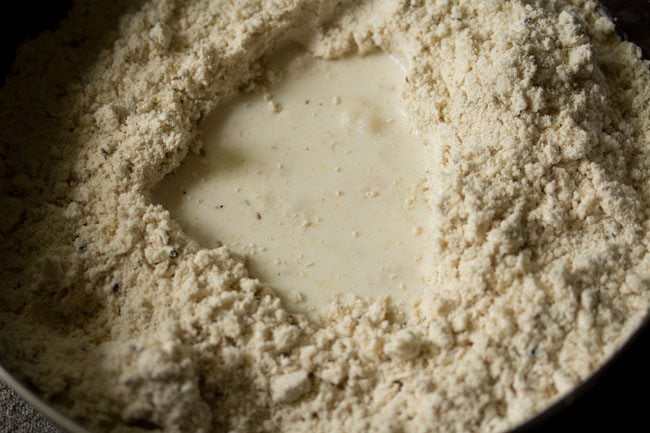
9. Start to knead.
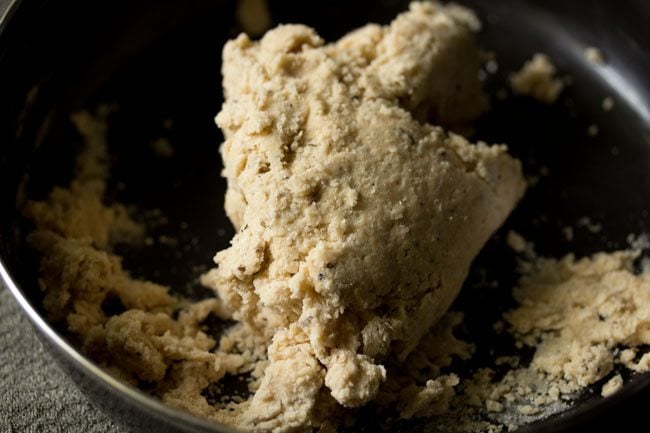
10. Knead until you get a firm dough. Make sure the dough is not too soft.
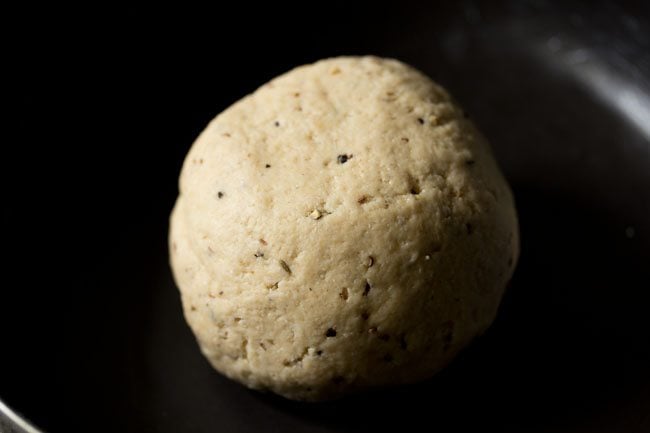
11. Cover the dough with a moist muslin or cotton and let it rest for 20 to 30 minutes at room temperature.

12. Then knead again.
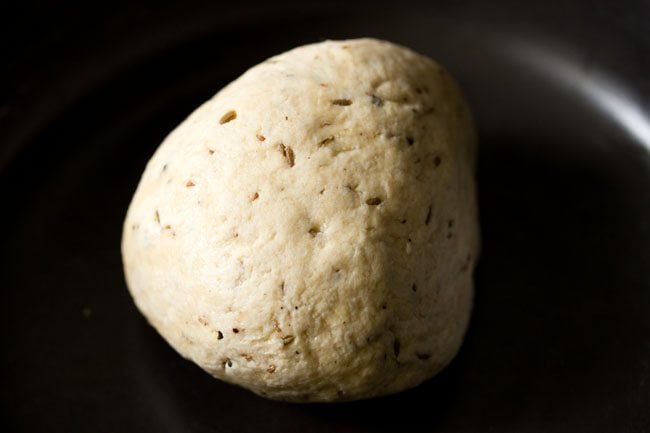
Roll and Slice
13. Roll into a log.
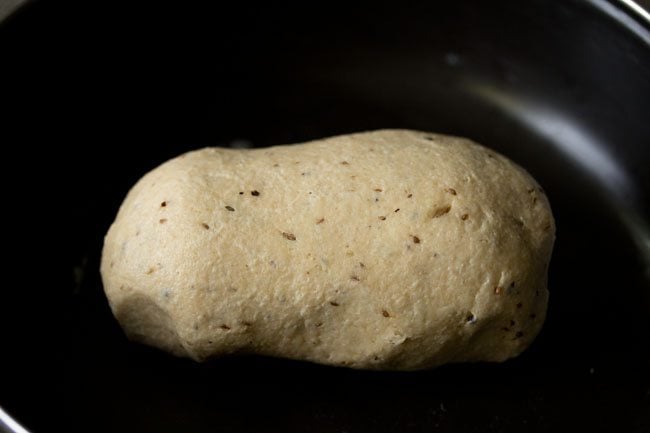
14. Then divide the dough into three parts and roll each into balls in the palm of your hands. Cover with a moist muslin cloth.
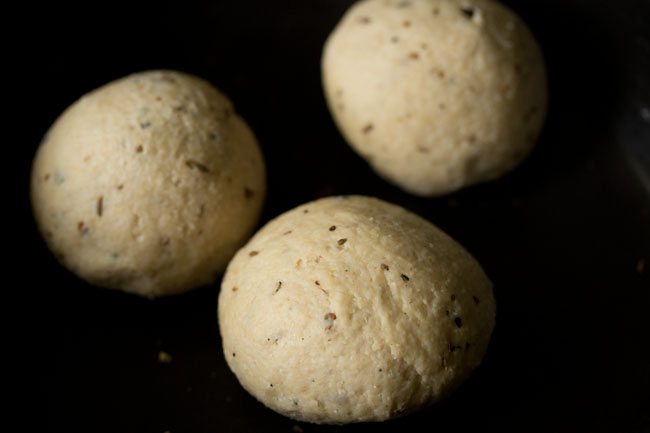
15. Now take one part and begin to roll it into a disc or circle.

16. The circle should be 6 to 7 inches in diameter having 5 to 7 mm thickness. Ensure that it is not too thick or thin in thickness.
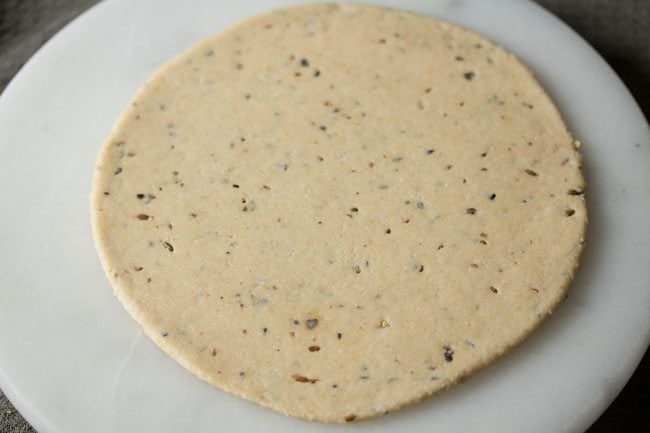
17. Now with a knife or pizza cutter, cut the dough into diagonal strips.
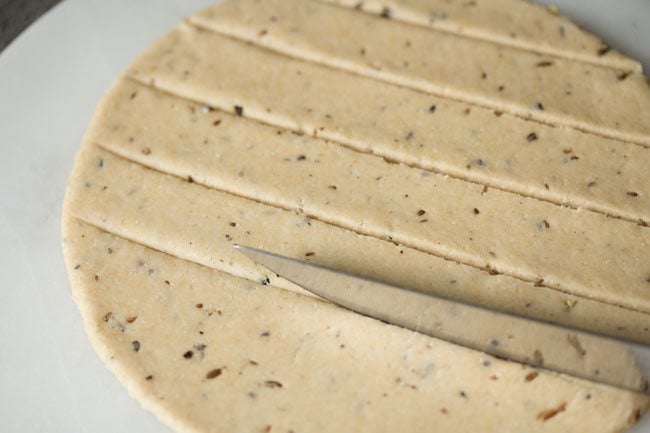
18. Then cut again to make diamond shapes or square shapes in the dough.

19. Separate the diamonds. Cover with a clean kitchen napkin and set aside once you begin to heat the oil.
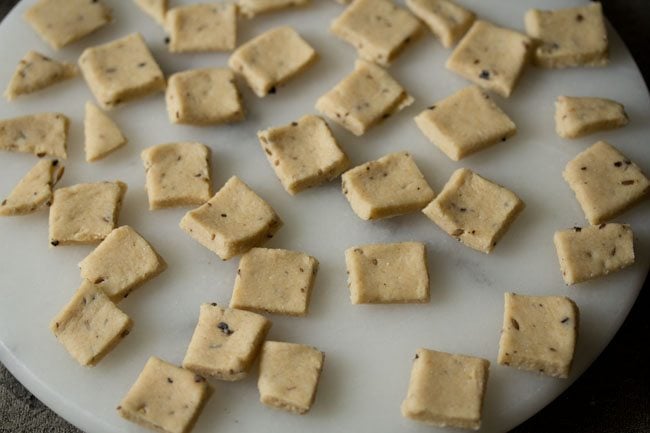
Fry Khare Shankarpali
20. Heat oil in a kadai or pan.

21. Before you begin to fry, add a small piece from the dough to check that the oil is at the right temperature. It should be medium hot.
If the small piece of dough floats to the top and comes up gradually, then the dough is ready to be fried.
However, if it comes to the top too quickly, then the oil is too hot, so reduce the heat. When the oil is too hot, the shankarpali will cook on the outside and be raw in the center.
If it floats to the top slowly or stays at the bottom, the oil needs to be hotter. A warmer temperature in the oil will result in an oily shankarpali.
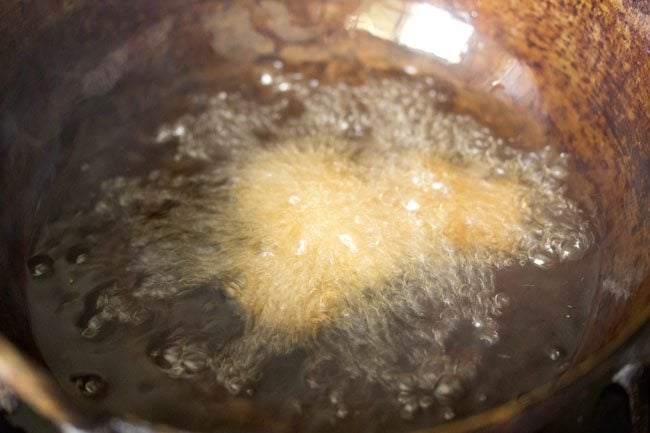
22. When the oil is medium hot, add the shankarpali pieces and do not overcrowd the kadai or pan. Add a few pieces at a time and fry in batches.
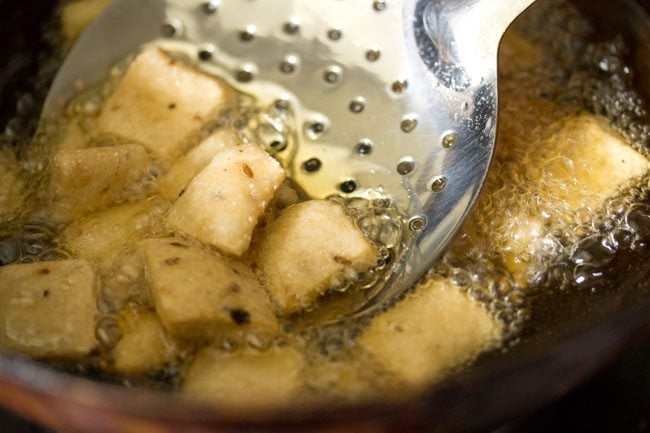
23. Use a slotted spoon to turn over and fry one side of the shankarpali until it becomes golden.

24. Flip a couple of times and fry to get an even golden color. Once golden, remove using a slotted spoon.
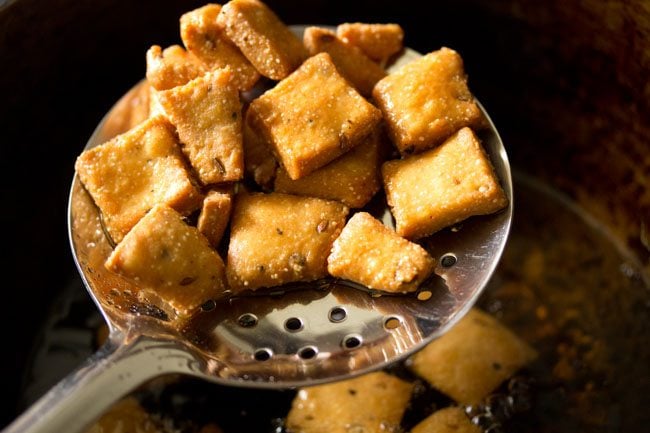
25. Drain them on a kitchen paper towels to remove excess oil and once cooled, store them in an air-tight container or jar.

26. Serve savory shankarpali as a tea time snack.

Expert Tips
- Dough: The dough must be stiff, tight and firm to achieve the best texture for both the shankarpali recipes. Make sure it is not too dry as this may cause the dough to crack when rolling. If the dough is too wet then the shankarpali may become soft and not crispy. Remember to cover the dough with a clean kitchen towel or moist kitchen napkin when not using it.
- Oil: When frying shankarpali the oil must be at a medium temperature. That is not too hot or cool. To test the oil rip a small section of dough and gently drop it into the oil. The dough should gradually float to the top of the oil. If it floats slowly then it is too warm and if it floats to the top too quickly then it is too hot. For the perfect temperature adjust the heat accordingly.
- Frying: Make sure you don’t add too much of the dough pieces to the oil when frying. This may cause the oil to cool down and slow down the frying. To avoid this fry the shankarpali in batches. Add the numbers according to the size of the pan or kadai.
- Variations: Bake or fry the shankarpali depending on your preference. You can also make these snacks sweet or savory.
FAQs
It is likely that the dough was not kneaded for long enough or is too soft. Make sure the dough is firm before rolling and frying to get the best results.
No. Semolina is not ground in this recipe. Fine semolina is used so there is no need to grind it. However, if the semolina is large and coarse then you can grind it.
No. Avoid using honey in food that is cooked or baked. When honey is heated it becomes toxic as per Ayurveda. If you don’t have any sugar then it is better to make the savory version instead. Add some carom seeds (ajwain), crushed black pepper and cumin seeds and salt.
More Festive Snacks!
Sweets Recipes
Evening Snacks
Eggless Cookies & Biscuits
Please be sure to rate the recipe in the recipe card or leave a comment below if you have made it. For more vegetarian inspirations, Sign Up for my emails or follow me on Instagram, Youtube, Facebook, Pinterest or Twitter.

Shankarpali Recipe
Ingredients
- 1.5 cups all purpose flour (maida)
- ⅓ cup rava – finer variety (sooji or semolina)
- ½ cup sugar or raw sugar, add as required
- 1 pinch salt
- 3 to 4 tablespoons milk or add as required
- 2 tablespoon melted ghee or oil for fried shankarpali and 3 tablespoon melted ghee or oil for baked shankarpali
- oil as required for deep frying
Instructions
Kneading dough
- Powder the sugar in a dry grinder and keep aside.
- First sieve the flour with salt.
- Then sieve the powdered sugar.
- Melt some ghee or warm the oil in a small pan. For ghee measure the melted ghee to 2 tablespoons.
- Add the melted ghee or warm oil to the flour-semolina-sugar mixture. First mix with a spoon.
- Then with your fingers mix the fat into the flour mixture and make a breadcrumb like consistency.
- When gathered together, the whole mixture should be able to hold itself together.
- Warm the milk. Then add 1 tablespoon of the warm milk in intervals and knead to a firm tight dough.
- If the dough looks dry, then add 1 to 3 teaspoons milk and knead.
- Keep aside covered for 20 to 30 minutes for the dough to rest.
Frying shankarpali
- Heat oil for deep frying in a kadai or pan.
- Divide the dough into two or three equal parts and roll each into a neat ball. Keep covered with a kitchen napkin so that the dough does not dry out.
- Roll this ball into a disc having 5 to 7 mm thickness. Cut diamond or square shaped slices from the rolled dough.
- Gently drop 6 to 8 of these rolled shankarpali pieces into the kadai or pan.
- You can fry more if you have a bigger kadai or pan.
- When one side is golden, turn over with a slotted spoon and fry the second side until golden. If required turn over a few times for an even cooking and golden color.
- Remove with a slotted spoon and place the fried shankarpali on kitchen paper napkins. Fry the rest of the shankarpali in batches.
- Also roll the other piece of the dough in a similar way and make diamond shaped pieces. Fry these pieces too in batches.
- When cooled, store the shankarpali in an air-tight jar or container.
Baking shankarpali
- Preheat the oven to 180 degrees Celsius (356 degrees Fahrenheit).
- Place the diamond slices on to a baking tray or pan.
- Bake shankarpali for 20 to 25 minutes or until golden. Turn over half way through baking if needed.
- Remove and cool the baked shankarpali on a wired rack.
- Once cooled, store the baked shankarpali in an air-tight jar.
Notes
- You can add more sugar according to your taste preferences.
- Make sure to make stiff and tight dough. A soft dough will make for a soft shankarpali and they won’t be crispy or crunchy. Do not knead the dough for too long as this may result in a dense doughy texture.
- Fry on medium heat. A very hot oil will make them brown faster leaving the insides undercooked. A warm oil will make them soggy and loaded with oil.
- Fry in batches and do not overcrowd the pan. Add the number of shankarpali pieces according to the size of the pan or kadai you have.
- 2 tablespoons of oil or ghee is enough for the quantity of flour and sooji (rava) mentioned in this recipe if you plan to deep fry the shankarpali. If you add 3 tablespoons of oil or ghee then there are chances of the shankarpali breaking in the oil while frying. However 3 tablespoons of ghee or oil works well and gives the shankarpali a good texture if you bake them.
- Note that the approximate nutrition info is for 1 shankarpali.
Nutrition Info (Approximate Values)
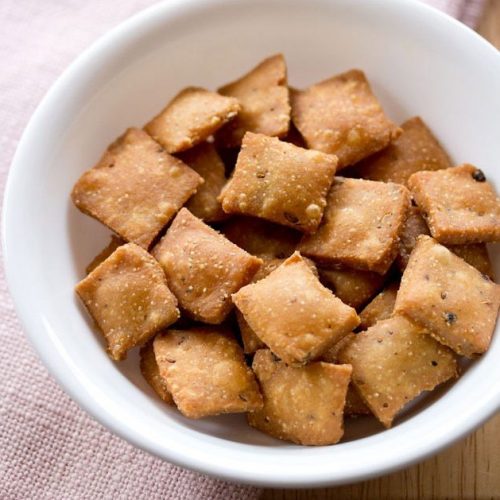
Khare Shankarpali
Ingredients
- ½ cup whole wheat flour – 60 grams
- ½ cup all purpose flour – 62 to 63 grams
- ¼ cup rava finer variety (sooji or cream of wheat) – 40 grams
- 2 tablespoons ghee or oil
- ½ teaspoon carom seeds (ajwain)
- ½ teaspoon cumin seeds
- ¼ teaspoon black peppercorns crushed or ½ to ⅔ teaspoon crushed black pepper
- ½ teaspoon salt or add as per taste
- ½ cup milk at room temperature, can also use water instead of milk
- oil for deep frying, as required
Instructions
Preparing dough
- Take the whole wheat flour, all purpose flour and fine rava in a mixing bowl or plate.
- Add carom seeds, cumin seeds, crushed black pepper and salt. Mix very well with a spoon. Set aside.
- In a small pan, heat 2 tablespoons ghee or oil.
- Add the melted ghee or hot oil to the flour mixture. First mix with a spoon.
- Then with your fingertips rub the ghee or oil in the flour mixture and make a breadcrumb like consistency. Take a portion of a mixture and press it in your palm. It should gather and hold itself.
- Now add milk to the mixture in parts. The milk should be at room temperature. You can also use water instead of milk. Add water as required.
- Mix and knead to a firm and stiff dough. The dough should not be soft.
- Cover the dough with a moist muslin or cotton napkin and let it rest for 20 to 30 mins at room temperature.
Rolling and making namkeen shankarpali
- Then knead lightly again. Roll into a log and divide the dough in three parts. In your palms, roll each part in to a ball.
- Now take one part and begin to roll it to a disc or circle of about 6 to 7 inches in diameter and having a thickness of 5 to 7 mm. Make sure the rolled dough is not too thick and not too thin in thickness.
- Now with a knife or pizza cutter, cut the dough in strips.
- Then again cut to give diamond shapes or square shapes from the dough.
- Separate the diamond shapes. Cover and keep aside when you begin to heat oil.
Frying khare shankarpali
- Heat oil for deep frying in a kadai or pan.
- Before you begin to fry, drop a small piece from the dough and check. The oil has to be medium hot. If the small piece of dough comes gradually and steadily on top, then the oil is ready to be fried.
- If it comes too quickly, then oil is very hot, so reduce the flame. If it comes slowly or stays at the bottom, the oil needs to get heated up. So increase the flame. If the oil is too hot, the shankarpali will be cooked from outside but raw from the center.
- When the oil is medium hot, add the shankarpali pieces.
- With a slotted spoon turn over and fry when one side of the shankarpali gets golden.
- Flip a couple of times and fry to get an even golden color.
- When golden, remove with slotted spoon and drain them on kitchen paper towels to remove extra oil. When cooled, store the shankarpali in an air-tight container or jar.
- Serve them as a snack.
Notes
- You can decrease the amount of spices if you want. Do not add more carom seeds than what is mentioned in the recipe. As it can result in the shankarpali becoming slightly bitter.
- Knead to a stiff and firm dough. Do not make the dough soft or too hard or dry.
- The recipe can be scaled to make a larger batch for festive occasions.
Nutrition Info (Approximate Values)
This Shankarpali recipe post from the archives first published in October 2013 has been updated and republished on 21 October 2022.
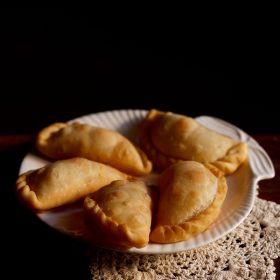
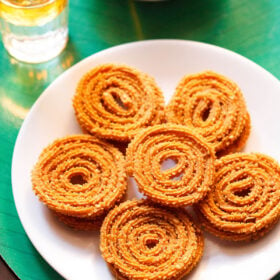
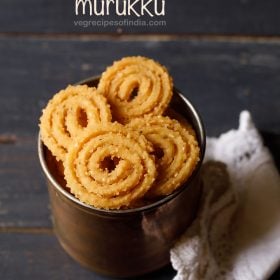
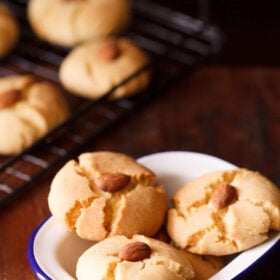













mam I want methi shankarpali
i will try to add the recipe. have taken a note of your recipe request.